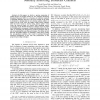TIT
1998
15 years 6 days ago
1998
—The key ideas in the theory of broadcast channels are illustrated by discussing some of the progress toward finding the capacity region. The capacity region is still unknown.
106
click to vote
GLOBECOM
2009
IEEE
15 years 4 months ago
2009
IEEE
In this paper, we consider the optimal rate and power allocation that maximizes a general utility function of average user rates in a fading multiple-access or broadcast channel. B...
101
Voted
ICS
1998
Tsinghua U.
15 years 4 months ago
1998
Tsinghua U.
In this paper we propose the OPTNET, a novel optical network and associated coherence protocol for scalable multiprocessors. The network divides its channels into broadcast and po...
136
click to vote
ICDCS
2002
IEEE
15 years 5 months ago
2002
IEEE
In the real-time environments, information is disseminated to clients with timing constraint. In this paper, we focus on the real time data scheduling problem in multiple broadcas...
113
click to vote
ICC
2009
IEEE
15 years 7 months ago
2009
IEEE
— In this paper, we derive a precise expression of spatial degrees of freedom (DOF) for two mutually interfering broadcast channels (IFBC) as a function of arbitrary numbers of t...
121
Voted
GLOBECOM
2009
IEEE
15 years 7 months ago
2009
IEEE
— In this paper, we provide a lower and upper bound for the number of degrees of freedom (DOF) of B multipleinput single-output (MISO) broadcast channels (BC) where each base sta...


